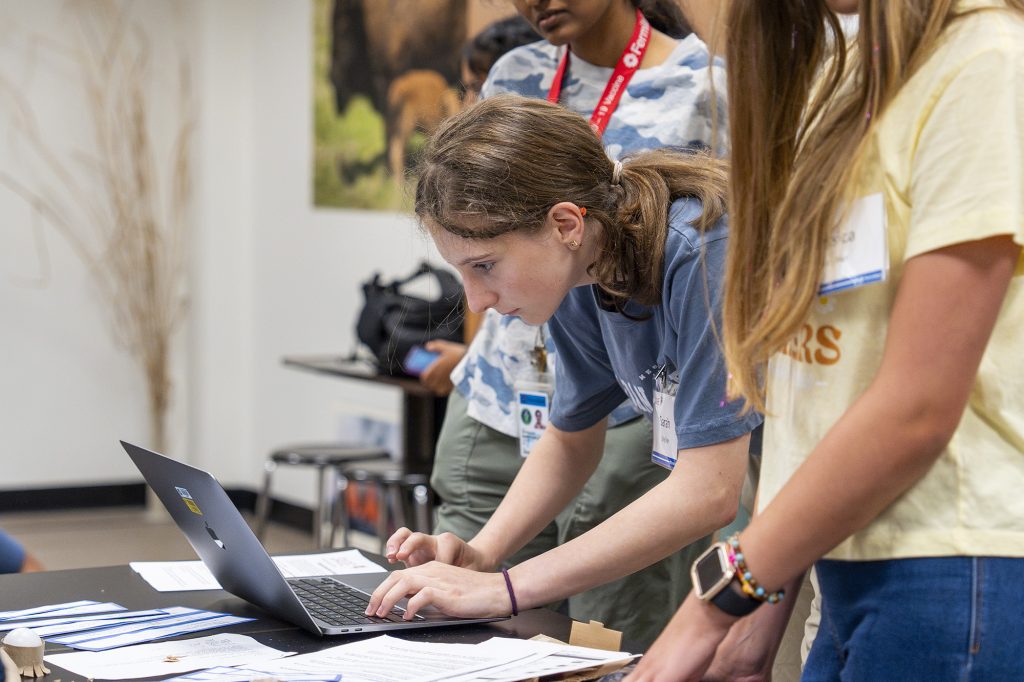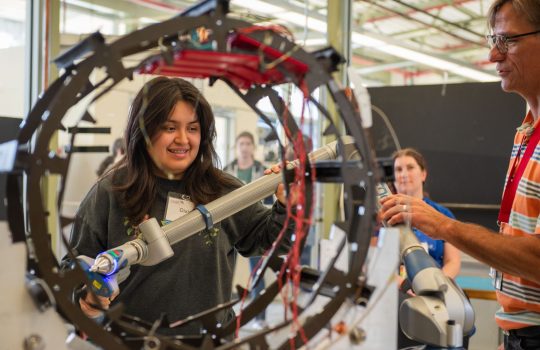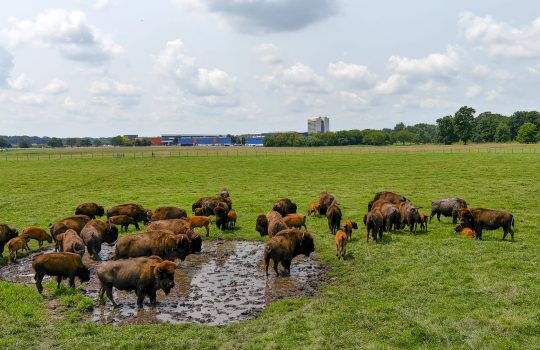Fermilab welcomed a diverse group of high school students to the Science Accelerating Girls’ Engagement Camp — a five-day summer science experience aimed to inspire students to pursue careers in a STEM field.
Students experienced science projects facilitated by Fermilab’s experts, tours of the Fermilab campus and laboratory spaces, and daily career discussions with Fermilab staff. At the end of the week, each student gave a presentation to their peers and instructors about what they learned.
“I liked seeing all the careers here,” said one of the students during her presentation. “Before this, I didn’t know there were so many styles of jobs. There’s a lot of pressure on us to sort out our futures. It’s nice to hear that we have so many options and time to figure it all out.”
SAGE students had the opportunity to build and program robots, gaining insight into how mechanical engineers and software developers maintain critical equipment at Fermilab. This two-day activity was led by Finley Novak, a controls engineer in the Fermilab accelerator directorate.

Teams of students work together with volunteers to design and build a robot capable of navigating a challenge course. Photo: Dan Svoboda, Fermilab
“I love gaining new knowledge,” said one student. “One thing I learned about myself is that I really enjoy coding. If I hadn’t come here, I wouldn’t have been exposed to Python or quantum computing, and I wouldn’t have made these awesome new friends.”
The students toured Fermilab’s Silicon Detector Facility, known as SiDet. This facility houses detectors that measure the position of charged particles in high-energy physics experiments, like the Compact Muon Solenoid, an experiment that includes a 14,000-ton detector designed to record high-energy proton collisions in the Large Hadron Collider at CERN.
“The students applied the concepts they learned during their week to better understand what we do here at SiDet,” said research associate Irene Zoi.
Zoi and her co-worker Doug Berry provided the SiDet tour. Berry is an associate scientist with the CMS experiment. On the tour, they shared how the devices detect charged particles to gather large amounts of data from particle collisions, and how researchers analyze this information.
In the Lederman Science Center’s MakerSpace, students learned how high-energy particles like cosmic rays can be detected. When the particles collide with the fine mist inside of a cloud chamber, they produce wispy trails that have historically helped researchers understand the particles’ properties. Scientist Gray Putnam, a Lederman Fellow and regular contributor to education outreach at Fermilab, led the students through a do-it-yourself cloud chamber activity. With Putnam’s guidance, students created mini cloud chambers using petri dishes, dry ice and rubbing alcohol.
At Fermilab’s Superconducting Quantum Materials and Systems Center, camp participants got an up-close look at the Quantum Garage, a laboratory space that houses large dilution refrigerators capable of reaching cryogenic temperatures just a tick above absolute zero. The fridges host test platforms for performing research that can advance quantum computing capabilities.
“Quantum computing is a topic I’ve always wanted to learn more about,” said one student. “I only understood half of the tour, but I learned more about a topic that’s always interested me.”
Each day during the camp a lunchtime career discussion was held with a different Fermilab expert to help students understand how they may pursue a variety of STEM careers.

Students learn basic coding skills to program small robots to complete a challenge. Photo: Dan Svoboda, Fermilab
Caitlyn Buongiorno, Fermilab’s social media manager; Roshanda Spillers, accelerator and computing technician; Jemila Adetunji, head of quality assurance; Minerba Betancourt, particle physicist; and Lia Merminga, lab director, all discussed their roles and how they support Fermilab’s scientific mission.
Mari Oates, Fermilab’s educational digital learning and MakerSpace manager, and Jennifer Raaf, a senior scientist on the upcoming DUNE experiment organized and led the 2024 SAGE Camp.
“One of our goals is to help the students feel like they have an entry point into the world of STEM,” said Oates. “SAGE helps cultivate the next generation of STEM employees.”
SAGE Camp is one of Fermilab’s many education and public engagement initiatives. Like other initiatives, the camp leverages the laboratory’s expertise in cutting–edge research.
“One of the great aspects of SAGE Camp is students can build on what they have learned here,” said Putnam. “They can take this information, go out into the world and do something with it.”
Information about SAGE Camp and other educational programs can be found on the Fermilab Education and Public Engagement website, education.fnal.gov.
The SAGE program is supported by the Gordon and Betty Moore Foundation, the Office of High Energy Physics within the DOE Office of Science and many volunteers at DOE national laboratories.
Fermi National Accelerator Laboratory is supported by the Office of Science of the U.S. Department of Energy. The Office of Science is the single largest supporter of basic research in the physical sciences in the United States and is working to address some of the most pressing challenges of our time. For more information, please visit science.energy.gov.



